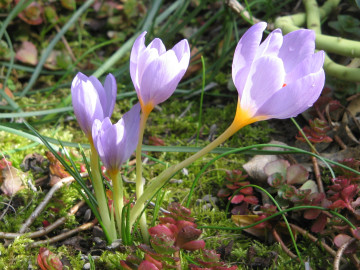Leonard Moorehead, the Urban Gardener: Gleeful Spring Approaches
Saturday, February 25, 2017
Early morning birdsong is pure music. Before the urban rumble begins is the quiet time. Throughout the year I rise early and greet the day garden side. I scan the heavens for Venus, Mercury the Moon and constellations. Orion sinks to the Southeast. My feet are grateful off pavement. Gravity holds toes, arches, and ankles earthbound. Peaceful, profound, the Earth draws downward roots, our bodies cannot escape. Dawn’s rosy fingers reach out above us, rooted we gaze upwards towards her bright fingers. Our senses are alive. A cardinal sings. Sparrows join the chorus. In song the ranks, choirs and all the cherubim of heaven encourage life’s joyous renewal.
There are countless gentle voices. I listen, for those who seek much is found. Hazelwood has forgotten northern gales. Fragrant petite golden starburst blooms sprout from their leafless boughs. Lenten Roses are pink pastel tenors. Of more immediate interest are random bumps in the mulch, a glimpse of green and yes, the tulips are rising. Tucked in out of the way corners are ivory white snowdrops. Winter no longer commands. Our spirits rise. We are quick to add notes and chorus, we itch to translate bright green visions into reality. The most cosmosphile are ready to act, this spring we will plant a garden. Homage has many realities.
Explore. Urban centers across the country are greener. Do you feel the urge to plant, nurture and taste the abundant life? Community gardens are ever more common. Abandoned house sites in old neighborhoods no longer harbor trash, many are garden oasis. Others like you see opportunity and act. Join them, you are not a stranger. Near you are virtually free spaces, most have bulletin boards and all have friendly people who dismiss opinion and recognize kindred. Some community gardens are independent, most are part of umbrella organizations. Perhaps a vacant lot inspires the pioneer in you or offers a chance to reclaim a local green space. Look for a nearby community garden and enroll. You won’t be sorry. From my apartment in a historic congested neighborhood a corner lot was only 2 houses down the sidewalk and a right turn through an ancient forsythia archway, all that remained a from long ago house. What luck!
GET THE LATEST BREAKING NEWS HERE -- SIGN UP FOR GOLOCAL FREE DAILY EBLASTWhat is a community garden? Most are simple forthright places with few burdensome requirements beyond willingness. All benefit from shared resources, in my city dump truck loads of compost is donated by the city free for sharing. Free garden classes do not have pre-requisites. Cannot distinguish a petunia from a marigold? Fear not, the A, B, C’s of gardening launch all of us into the company of others who willingly share experience. Our pluralism is never more apparent, community gardeners are from cultures and horticultural traditions of many types. Sugar canes sold to eat by a sidewalk produce vendor rooted just as he predicted, “In my country we cut stalks like this and stick in the ground to grow, taste one, they are sweet”. Sugar cane is sweeter in the garden.
But you don’t want to grow sugar but raise nutritious food free from chemicals, insecticides and mischievous marketing. You crave the chance to grow your own. Whether the community garden, the neutral zone between sidewalk and street, window flower boxes, pots or a small backyard with precious off street parking, you can grow your own on a shoe string. The rewards are enormous.
Select high value plants for your spring garden. Shallots or leeks over yellow onions are something we all understand, a notch above at much, much lower cost. Do home garden plants offer more than those displayed in markets? Yes, yes, yes. Somehow flavor and taste have receded from our shelves. Choices appear, freedom to choose cultivars that our ancestors favored when carried from the garden to the kitchen or eaten on the spot often fail to survive long distance transport. Left behind in the need to feed the multitude and profit large organizations, these heirlooms are yours. Savor the sweet fingerling carrots thinned from the thick seeded row, washed at the tap. Discover the astounding flavor of beet leaves, usually discarded before sale.
Visit local farmer’s markets for plants that thrive in your regional climate. Buy red carrots and prepare a dish. Peruse the many types of potato offered at farmer’s markets, a blue potato will capture a child’s imagination far faster than a white spud. Compare prices, many farmers offer vegetables such as blue, gold, and red potatoes at costs below those of seed houses. Cut up in large pieces with an “eye” or two to grow your own. Do your ambitions exceed garden space? Does the relentless endeavor for shelter, housing and employment limit time? Purchase garden shares from cooperative local farmers. Enjoy foods in season grown close to home. Most of us discover a full share is much larger than anticipated. Split with family and friends. Gather together, prepare meals and enjoy personal time with others. Save the peels, cores, and meatless leftovers for the compost heap. Make new friends, become closer to old ones, and expose youngsters to new experience. Many local farmers welcome volunteers to tend and harvest crops throughout the growing seasons. Here’s a practical hands on learning opportunity at no risk. Fresh air, sunshine, and healthy exercise on the local farm are free, do not under rate unscripted freedoms.
But you ask, what should I plant now? Cool weather or late winter- early spring crops are success stories. Consider the salad bowl: spinach, the many beets, not only the common red radish but the many Japanese types, are beginnings. Move forward, reach outwards. Arugula is so successful in Zone 6 it has naturalized in many community gardens and will in yours too. Look for green sprouts along the garden margin, if the wildlings are up, you may plant. Mustard, collards, cress, and the lettuces are proven winners. Don’t overlook flavorful and nutritious herbs such as parsley and chives. Open spaces in the mulch or make shallow trenches or bowls in your garden, keep organic materials besides the open soil surface. Label each plant for easy identification until you recognize seedlings as juvenile versions of familiar mature plants.
Is there anything to harvest in late winter? Yes. Leeks, kale, potatoes and shallots over winter in fine condition. A very thick mulch in my garden kept the soil frost free, leeks, turnips, garlic, potatoes robust. Pull back the mulch and pull up fine vegetables for this evening’s stew. Hearty root crop stews fortify us against March’s tumultuous entrance, winter’s grip is loosened not entirely forgotten.
Rise up in the morning. Foot yourself on unpaved ground. Gaze beyond the horizon. Listen, the cardinal sings his proud song. Join me he calls out. Go ahead. You’re welcome and belong. Rejoice, life is constant renewal. Doubtful? A green thumb? You have one.
Leonard Moorehead is a life- long gardener. He practices organic-bio/dynamic gardening techniques in a side lot surrounded by city neighborhoods in Providence, RI. His adventures in composting, wood chips, manure, seaweed, hay and enormous amounts of leaves are minor distractions to the joy of cultivating the soil with flowers, herbs, vegetables, berries, and dwarf fruit tree.
Related Articles
- Leonard Moorehead, The Urban Gardener: Frost Bites
- Leonard Moorehead, the Urban Gardener: Mums the Word
- Leonard Moorehead,The Urban Gardener: Minor Bulbs Rule
- Leonard Moorehead, the Urban Gardener: Leaf Harvests
- Leonard Moorehead, the Urban Gardener: Stormy Horizons
- Leonard Moorehead, the Urban Gardener: Glorious Asters Star
- Leonard Moorehead, The Urban Gardener: Infinity Beckons
- Leonard Moorehead, The Urban Gardener: A World in a Drop of Water
- Leonard Moorehead, the Urban Gardener: Some Like it Hot
- Leonard Moorehead, The Urban Gardener: Celebrate the Fall Equinox
- Leonard Moorehead, The Urban Gardener: The Fragrant Garden - Herbs for All
- Leonard Moorehead, the Urban Gardener: Garden Gratitude
- Leonard Moorehead, the Urban Gardener: Garden Size Love Handles
- Leonard Moorehead, the Urban Gardener: Snug and Warm
- Leonard Moorehead, The Urban Gardener: Winter Blooms
- Leonard Moorehead, the Urban Gardener: Darkest Before the Dawn
- Leonard Moorehead, the Urban Gardener: Dreams Come True
- Leonard Moorehead, the Urban Gardener: My Love is Like a Red, Red, Rose
- Leonard Moorehead, the Urban Gardener: From Acorns Mighty Oaks Grow
- Leonard Moorehead, the Urban Gardener: Bless the Resolute
- Leonard Moorehead the Urban Gardener: “Scent, First and Last”
- Leonard Moorehead, the Urban Gardener: Holly Saves Us
- Leonard Moorehead, the Urban Gardener: Winter Solstice
- Leonard Moorehead, the Urban Gardener: Hallelujah, the Leek
- Leonard Moorehead, the Urban Gardener A Mere Thaw?




